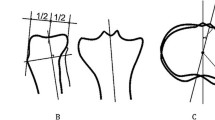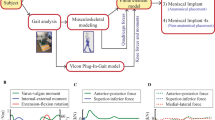Abstract
The objective of this study was to validate an in vitro human cadaver knee-joint model for the evaluation of the meniscal movement during knee-joint flexion. The question was whether our model showed comparable meniscal displacements to those found in earlier meniscal movement studies in vivo. Furthermore, we determined the influence of tibial torque on the meniscal displacement during knee-joint flexion. Three tantalum beads were inserted in the medial meniscus of six human-cadaver joints. The knee joints were placed and loaded in a loading apparatus, and the movements of the beads were determined by means of RSA during knee-joint flexion and extension with and without internal tibial (IT) and external tibial (ET) torque. During flexion without tibial torque, all menisci moved in posterior and lateral direction. The anterior horn showed significantly greater excursions than the posterior horn in both posterior and lateral direction. Internal tibial torque caused an anterior displacement of the pathway on the tibial plateau. External tibial torque caused a posterior displacement of the pathway. External tibial torque restricted the meniscal displacement during the first 30° of knee-joint flexion. The displacements of the meniscus in this experiment were similar to the displacements described in the in vivo MRI studies. Furthermore, the application of tibial torque confirmed the relative immobility of the posterior horn of the meniscus. During external tibial torque, the posterior displacement of the pathway on the tibial plateau during the first 30° of flexion might be restricted by the attached knee-joint capsule or the femoral condyle. This model revealed representative meniscal displacements during simple knee-joint flexion and also during the outer limits of passive knee-joint motion.





Similar content being viewed by others
References
Blankevoort L, Huiskes R, de Lange A (1988) The envelope of passive knee joint motion. J Biomech 21:705–720
Bylski-Austrow DI, Ciarelli MJ, Kayner DC, Matthews LS, Goldstein SA (1994) Displacements of the menisci under joint load: an in vitro study in human knees. J Biomech 27:421–431
Cox JS, Nye CE, Schaefer WW, Woodstein IJ (1975) The degenerative effects of partial and total resection of the medial meniscus in dogs’ knees. Clin Orthop 109:178–183
Fairbank TJ (1948) Knee joint changes after meniscectomy. J Bone Joint Surg Br 30:664–670
Fu FH, Thompson WO (1999) Motion of the meniscus during knee flexion. In: Mow VC, Arnoczky SP, Jackson DW (eds) Knee meniscus: basic and clinical foundations. Raven, New York, pp 75–89
Klompmaker J, Veth RP, Jansen HW, Nielsen HK, de Groot JH, Pennings AJ (1996) Meniscal replacement using a porous polymer prosthesis: a preliminary study in the dog. Biomaterials 17:1169–1175
Selvik G (1974) A roentgenstereophotogrammatic method for the study of the kinematics of the skeletal system. Thesis, University of Lund
Smith JP III, Barrett GR (2001). Medial and lateral meniscal tear patterns in anterior cruciate ligament-deficient knees. A prospective analysis of 575 tears. Am J Sports Med 29:415–419
Thompson WO, Thaete FL, Fu FH, Dye SF (1991) Tibial meniscal dynamics using three-dimensional reconstruction of magnetic resonance images. Am J Sports Med 19:210–215
van Kampen A, Huiskes R (1990) The three-dimensional tracking pattern of the human patella. J Orthop Res 8:372–382
Vedi V, Williams A, Tennant SJ, Spouse E, Hunt DM, Gedroyc WM (1999) Meniscal movement. An in-vivo study using dynamic MRI. J Bone Joint Surg Br 81:37–41
Walker PS, Erkman MJ (1975) The role of the menisci in force transmission across the knee. Clin Orthop 109:184–192
Author information
Authors and Affiliations
Corresponding author
Rights and permissions
About this article
Cite this article
Tienen, T.G., Buma, P., Scholten, J.G.F. et al. Displacement of the medial meniscus within the passive motion characteristics of the human knee joint: an RSA study in human cadaver knees. Knee Surg Sports Traumatol Arthrosc 13, 287–292 (2005). https://doi.org/10.1007/s00167-004-0511-y
Received:
Accepted:
Published:
Issue Date:
DOI: https://doi.org/10.1007/s00167-004-0511-y




